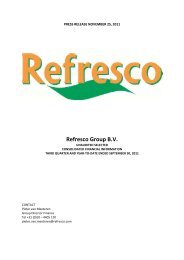Create successful ePaper yourself
Turn your PDF publications into a flip-book with our unique Google optimized e-Paper software.
Financial review 2009<br />
Transactions eliminated on consolidation<br />
Intra-group balances and transactions, and any unrealized<br />
income and expenses arising from intra-group transactions, are<br />
eliminated in preparing the consolidated financial statements.<br />
Unrealized losses are eliminated in the same way as unrealized<br />
gains, but only to the extent that there is no evi<strong>de</strong>nce of<br />
impairment.<br />
2.2 Foreign currency<br />
Foreign currency transactions<br />
Transactions in foreign currencies are translated into the<br />
respective functional currencies of Group entities at the<br />
exchange rates at the dates of the transactions. Monetary<br />
assets and liabilities <strong>de</strong>nominated in foreign currencies at the<br />
reporting date are translated into the functional currency at the<br />
exchange rate at that date. The foreign currency gain or loss<br />
on monetary items is the difference between amortized cost in<br />
the functional currency at the beginning of the period, adjusted<br />
for effective interest and payments during the period, and the<br />
amortized cost in foreign currency translated at the exchange<br />
rate at the end of the period. Non-monetary assets and liabilities<br />
<strong>de</strong>nominated in foreign currencies that are measured<br />
at fair value are retranslated into the functional currency at the<br />
exchange rate at the date that the fair value was <strong>de</strong>termined.<br />
Foreign currency differences arising on translation are recognized<br />
in profit or loss, except for differences arising on financial<br />
liabilities <strong>de</strong>signated as a hedge of the net investment in a<br />
foreign operation, which are recognized in the foreign currency<br />
translation reserve (FCTR).<br />
Foreign operations<br />
The assets and liabilities of foreign operations, including good-<br />
will and fair value adjustments arising on acquisition, are trans-<br />
lated into Euros at the exchange rate at the reporting date. The<br />
income and expenses of foreign operations are translated into<br />
Euros at the exchange rates at the dates of the transactions.<br />
Foreign currency differences arising thereon are recognized,<br />
in other comprehensive income, in the FCTR. When a foreign<br />
operation is disposed of, either in part or in full, the associated<br />
cumulative amount in the FCTR is transferred to profit or loss<br />
as an adjustment to the profit or loss on disposal.<br />
Foreign exchange gains and losses arising on a monetary item<br />
receivable from or payable to a foreign operation, the settlement<br />
of which is neither planned nor likely in the foreseeable<br />
future, are consi<strong>de</strong>red to form part of the net investment in the<br />
foreign operation and are recognized in other comprehensive<br />
income in the FCTR.<br />
Hedge of a net investment in a foreign operation<br />
Translation differences on intra-group long-term loans that<br />
effectively constitute an increase or <strong>de</strong>crease in a net<br />
investment in a foreign operation are recognized in other<br />
comprehensive income in the reserve for translation<br />
differences.<br />
2.3 Financial instruments<br />
Non-<strong>de</strong>rivative financial instruments<br />
Non-<strong>de</strong>rivative financial instruments comprise investments in<br />
held-to-maturity investments, tra<strong>de</strong> and other receivables, cash<br />
and cash equivalents, loans and borrowings, and tra<strong>de</strong> and<br />
other payables.<br />
Non-<strong>de</strong>rivative financial instruments are recognized initially at<br />
fair value plus, for instruments not at fair value through profit<br />
or loss, any directly attributable transaction costs. Subsequent<br />
to initial recognition, non-<strong>de</strong>rivative financial instruments are<br />
measured as <strong>de</strong>scribed below.<br />
Cash and cash equivalents comprise cash balances, checks in<br />
transit and call <strong>de</strong>posits. Bank overdrafts that are repayable<br />
on <strong>de</strong>mand and form an integral part of the cash management<br />
processes are inclu<strong>de</strong>d as a component of cash and cash<br />
equivalents for the purpose of the cash flow statement.<br />
The accounting for finance income and expense is <strong>de</strong>scribed in<br />
note 2.16.<br />
Held-to-maturity investments<br />
If the Group has the positive intent and ability to hold <strong>de</strong>bt<br />
securities to maturity, the securities are classified as heldto-maturity.<br />
Held-to-maturity investments are measured at







